|
|
|
Sort Order |
|
|
|
Items / Page
|
|
|
|
|
|
|
| Srl | Item |
| 1 |
ID:
142242
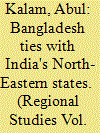

|
|
|
| 2 |
ID:
169360
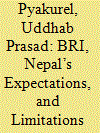

|
|
|
|
|
| Summary/Abstract |
Many Nepalese perceive China’s Belt and Road Initiative (BRI) as a useful means for the India-locked country to connect to other countries. However, this paper analyzes the weakening connectivity within the border areas of Nepal and Tibet since falling under Chinese control, concluding that China is unready to increase cross-border movement and trade facilities with Nepal due to perceived security concerns.
|
|
|
|
|
|
|
|
|
|
|
|
|
|
|
|
| 3 |
ID:
144658
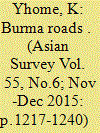

|
|
|
|
|
| Summary/Abstract |
Even as economic benefits are emphasized in India’s connectivity efforts with its
neighbors, strategic interests also drive Delhi’s connectivity interests. How promptly
Delhi addresses the structural, security, and geostrategic factors that pose major
challenges to India’s regional connectivity goals will determine its future role in the
region.
|
|
|
|
|
|
|
|
|
|
|
|
|
|
|
|
| 4 |
ID:
180650
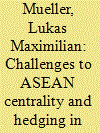

|
|
|
|
|
| Summary/Abstract |
Since 2010, ASEAN has made efforts to increase its coherence and visibility as an actor in regional infrastructure development, under the umbrella term of connectivity. Its most recent strategy, 2016’s Master Plan on ASEAN Connectivity 2025, is notable for its more focused agenda as well as a tableau of institutional innovations, including new policy coordination mechanisms and a project preparation pipeline. Nonetheless, ASEAN struggles to maintain coherence in the implementation of its connectivity agenda, both internally as well as towards its dialogue partners. Utilizing the concepts of centrality and hedging as parts of a unified theoretical framework, this paper analyzes ASEAN’s efforts to mobilize and manage external resources in connectivity. ASEAN’s resource dependence and its failure to establish institutional centrality creates issues at the regional and the national levels. Regionally, ASEAN’s lack of centrality and its perpetuation of ASEAN+1 relations have contributed to the emergence of contesting agendas and institutional frameworks by external actors. Nationally, the hedging strategies of ASEAN member states are at odds with the regional vision, highlighting a lack of intra-ASEAN coherence. The perpetuation of contesting institutional frameworks by external actors at the national level solidifies existing incoherence in ASEAN’s connectivity governance, further undermining its centrality. ASEAN’s efforts to assert centrality and execute a hedging strategy in connectivity are emblematic of its attempts to extend its reach into new policy areas, but also of its persistent governance constraints.
|
|
|
|
|
|
|
|
|
|
|
|
|
|
|
|
| 5 |
ID:
147631


|
|
|
|
|
| Summary/Abstract |
China's surge to become the world's second largest economy and largest trading nation contributes greatly to Asia becoming the world's largest economic system. China is the nexus of intra-Asian trade and direct investment flows. China's rapid growth in the recent decade relied on a state-directed investment model, akin to the state-run Big Push growth model. As in most big push experiences, intermediate term success leads to economic stresses. China's leaders can no longer ignore obvious signs of rising malinvestment, corporate debts, environmental degradation, and social disparity, all amid an aging population and tightening resource constraints. China's economic slowdown also forces economic adjustment upon its neighbors, rendered more difficult by China's policy ambiguity and volatility. Sill, China can be a positive long term influence in Asia, especially as it carries its market reforms to completion.
|
|
|
|
|
|
|
|
|
|
|
|
|
|
|
|
| 6 |
ID:
097647
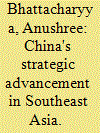

|
|
|
| 7 |
ID:
170189


|
|
|
|
|
| Summary/Abstract |
This article takes as its object of analysis the term ‘little freshness’ (xiao qingxin 小清新), which has been coined to describe a variety of cultural products and phenomena, mostly emanating from Taiwan but circulating across the Taiwan Strait. It argues that little freshness is a manifestation of subcultures that have been initiated, appropriated, and consumed by youths in the region. This citizen-to-citizen connectivity reworks Joseph Nye’s notion of soft power by shifting the focus away from state agents and by reversing the direction of soft power flows to claim agency at the sites of reception. The article provides two case studies to demonstrate how an imaginary about Taiwan’s cleanness, clearness, and freshness has been projected by the media in the People’s Republic of China as a form of discursive construction and by Hong Kong citizens of Taiwan as a desirable destination for emigration. Finally, the article situates the little freshness phenomenon in relation to a propensity towards miniaturization in cultural formation in the region, and suggests that this propensity is inflected in a structure of feeling about generational injustice in the face of neoliberal capitalism.
|
|
|
|
|
|
|
|
|
|
|
|
|
|
|
|
| 8 |
ID:
121132


|
|
|
|
|
| Publication |
2012.
|
| Summary/Abstract |
Backed by studies finding only limited propensity for free-riding when communities have an interest in self-provision, the last few decades have seen a surge of interest in community-based development. A major caveat to the "second wave" of collective action studies, however, is that collective action often breaks down under hierarchical social relationships. This is unfortunate news for developing countries' rural societies, which are often entrenched in patron-client networks. Using a natural experiment found in the construction of a motorway, the article finds that clientelist relationships do not, in and by themselves, block peasant collective action. Rather, it is the interaction between clientelism and isolation that empowers patrons to block community-based projects. Peasants in connected villages face no such constraints, but instead rely on their patrons' assistance in collective projects, making the hierarchical network an additional resource.
|
|
|
|
|
|
|
|
|
|
|
|
|
|
|
|
| 9 |
ID:
149645
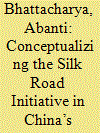

|
|
|
|
|
| Summary/Abstract |
While the Silk Route Initiative (SRI) appears to be a novel foreign policy strategy under Xi Jinping’s leadership, it is integral to China’s periphery policy (zhoubian zhengce). Arguably, periphery policy is rooted in the Chinese imperial history and has remained a salient aspect of state formation and foreign policymaking of the post-1949 China. Under Xi Jinping, it has acquired a preeminent foreign policy goal. This study puts the SRI in a historical framework and argues for the centrality of periphery in China’s domestic and foreign policy. Looking at the SRI from the prism of periphery, while suggesting an essential continuity in Chinese foreign policy and strategic thinking, also indicates that periphery is not simply a frontier strategy. Rather, it encompasses the whole gamut of Chinese domestic and foreign policy. Embedded thus in the periphery policy, the SRI is a well thought-out Chinese grand strategy to reclaim its geopolitical dominance in Asia and fulfill the goal of “China dream.” This strategy, in effect, challenges the US dominance and de-centers it from Asia and helps China to create a Chinese-centered order in Asia and beyond.
|
|
|
|
|
|
|
|
|
|
|
|
|
|
|
|
| 10 |
ID:
162733
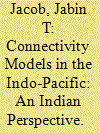

|
|
|
|
|
| Summary/Abstract |
China’s Belt and Road Initiative (BRI) is often sold as a project that aims to meet the infrastructure deficit in many underdeveloped parts of the world. However, Chinese projects under the BRI come with features that have negative short-term and long-term implications for the host countries in question. Chinese project financing almost uniformly lacks transparency, including about the terms of this financing, and is accompanied by uncertainty about local benefits such as employment and by poor standards. This paper begins by highlighting some key features of Chinese infrastructure projects under the BRI, before it examines, in detail, the financing of these projects, particularly in South Asia. The article concludes by stating that China’s success in pushing the BRI – despite its several problems – is the result of the inability of democratic nations to come up with feasible alternatives that respect local sensitivities and conditions in the countries in need of infrastructure development. India, especially, has much to reflect upon in respect of its own methods and approaches towards its neighbours and towards overseas development assistance in the wake of China’s BRI.
|
|
|
|
|
|
|
|
|
|
|
|
|
|
|
|
| 11 |
ID:
180001


|
|
|
|
|
| Summary/Abstract |
This article studies the relationship between care, family connectivity and queer selfhood in a Muslim-majority context. Based on fieldwork in Amman, Jordan, the article explores how queer people find themselves in demanding circumstances figuring out how to care for—and be responsible to—their family members, whilst caring for themselves at the same time. Drawing partly on Suad Joseph’s patriarchal connectivity and Lotte Meinert and Lone Grøn’s contagious kinship connections, I argue that if we are to understand queer selfhood in Jordanian and other Arab, Muslim-majority contexts in more nuance, we need to look at the relations and emotions at stake in care. Through selected ethnographic cases—in particular one that deals with heartaches—we take a closer look at how queer selfhood is constituted in response to, and up against care and control dynamics in the family. This exposes the interrelated and emotionally contagious qualities of kinship, sexuality and gender. It moves us beyond an understanding of queer subjectivities at the margins of a Muslim community, and towards an understanding of what care and queer selfhood in Muslim and Arab contexts also involves becoming through the hands and hearts of others.
|
|
|
|
|
|
|
|
|
|
|
|
|
|
|
|
| 12 |
ID:
115218
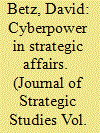

|
|
|
|
|
| Publication |
2012.
|
| Summary/Abstract |
This article explores the effect of connectivity on strategic affairs. It argues that the effect on war's character is potentially, although not yet shown in practice, considerably large. Its effect upon the distribution of power among states in the international system is small, contrary to the claims of `cyberwar' alarmists. All told, however, its effect upon strategic affairs is complex. On the one hand, it represents a significant advance in the `complexification' of state strategies, understood in the sense of the production of intended effects. On the other hand, strategists today - still predominantly concerned with the conflicts and confrontations of states and organised military power - are generally missing the power which non-traditional strategic actors, better adapted to the network flows of the information age, are beginning to deploy. These new forms of organization and coercion will challenge the status quo.
|
|
|
|
|
|
|
|
|
|
|
|
|
|
|
|
| 13 |
ID:
170621


|
|
|
|
|
| Summary/Abstract |
Ensuring energy security has emerged as one of the key challenges all over the world. To meet that challenge, countries have resorted to increasing cooperation among themselves which resulted in many successful energy connectivity initiatives. In South Asia, countries are facing increasing energy demand with its rapid economic development. The concept of energy cooperation is not new in South Asia and countries have tried to initiate it through many regional and sub-regional forums. However, the success in implementing them has been very limited. This paper tries to understand why energy connectivity initiatives in South Asia has remained elusive. To that end, the paper conceptualizes energy connectivity and identifies enabling factors that help a n energy connectivity initiative. It finds that some of those factors are missing in South Asia, which is why implementing energy connectivity initiatives has been challenging and the challenges are often intertwined. The paper concludes by stressing that energy connectivity is vital for meeting the future energy needs of the region and countries should take a step by step approach to implement it.
|
|
|
|
|
|
|
|
|
|
|
|
|
|
|
|
| 14 |
ID:
124485


|
|
|
|
|
| Publication |
2013.
|
| Summary/Abstract |
Singapore's post-independence leaders perceived the country's vulnerability in terms of its miniscule size, lack of resources and hinterland, fragile ethnic harmony and geo-strategic location surrounded by larger, and potentially hostile, neighbours. Given such odds, Singapore sought to become a global city by tapping into international flows of goods and trade. Becoming a core node in the global economy also enhanced Singapore's strategic relevance, upping major powers' interest in its survival. However, due to its global connectivity Singapore's exposure to rapidly spreading global risks, such as pandemics and financial crises, has become increasingly noticeable. This paper seeks to uncover a paradox in Singapore's ambition to become a global city as new vulnerabilities emerge from its highly globalized status. Through a discourse analysis of policy-makers' statements and speeches, it reveals that a recurrent theme of perceived vulnerability today relates to the extensive global maritime, aviation and financial flows on which Singapore's continued prosperity depends. The paper concludes that the critical infrastructure that underpin its global connectivity - its airport, maritime port hub and financial centre - can also unwittingly circulate and import global risks such as pandemics, Weapons of Mass Destruction proliferation, financial contagion and terrorist financing, adding a new dimension to how its leaders perceive vulnerability.
|
|
|
|
|
|
|
|
|
|
|
|
|
|
|
|
| 15 |
ID:
161985
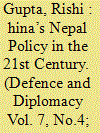

|
|
|
| 16 |
ID:
160455


|
|
|
|
|
| Summary/Abstract |
Since the 1990s India has been committed to the completion of the Chabahar Port despite external and internal constraints that slowed the project’s development. This article explores the reasons behind Indian interest in the development of the Chabahar Port, and the challenges this project continues to face.
|
|
|
|
|
|
|
|
|
|
|
|
|
|
|
|
| 17 |
ID:
153115


|
|
|
|
|
| Summary/Abstract |
China’s One Belt, One Road (OBOR) initiative has attracted worldwide attention, and a solid
foundation for the initiative has been laid at home and in the neighbouring regions of Southeast Asia.
While many countries may not have imagined the possibility of reviving the Silk Route, China has not
only coined the term OBOR but also taken steps to bring it close to reality. Despite the various challenges
posed by the initiative to their national strategies and to the regional security order, developing countries
along the OBOR have an opportunity to improve connectivity and transform their economic conditions by
exploring complementarities through trade, investment and greater people-to-people exchanges. From the
South Asian point of view, OBOR presents multiple opportunities as well as dilemmas. The puzzles need
to be addressed to shape the connectivity agenda of the region and to harness the benefits of integration,
which may require joint development and sharing of responsibility among economically stronger countries.
Greater cooperation among South Asian countries will be critical in shaping the connectivity agenda,
through OBOR or otherwise, in the South Asian region.
|
|
|
|
|
|
|
|
|
|
|
|
|
|
|
|
| 18 |
ID:
170620


|
|
|
|
|
| Summary/Abstract |
The convergence of interests and shared sense of connectivity between Bangladesh and India have opened up potential of new business corridors between the former and the latter’s Northeast. But three states in that region, viz. Mizoram, Manipur and Nagaland are not engaging with Bangladesh like Tripura, Assam and Meghalaya; which needs to be addressed to unlock the potentials since both Bangladesh and Northeast India have been given importance in India’s ‘Act East Policy’. Enhancement of trade, investment, connectivity, energy, cultural exchanges, etc. are possible with seamless transport and communication network. The paper suggests that India’s Northeast serves as an easy source of raw materials and intermediate products for different industries in Bangladesh. Advanced infrastructural development with inland water connectivity, rail and road transportation will boost bilateral trade relations and open up more business opportunities with relatively less connected states of India’s Northeast.
|
|
|
|
|
|
|
|
|
|
|
|
|
|
|
|
| 19 |
ID:
175320


|
|
|
|
|
| Summary/Abstract |
The purpose of this article is to examine the prospect of the Belt and Road Initiative (BRI) from the perspective of Bangladesh. The article investigates fundamental aspects of China’s economic involvement in Bangladesh to understand the geo-economic basis of the initiative. In this respect, the objective and motivation behind Chinese involvement in Bangladesh’s economy are studied, and the political and economic challenges emanating from the participation of the latter country in the initiative are outlined. Methodologically, this research adopts a qualitative approach and relies on primary sources to collect data. It concludes with an observation that Chinese investments through BRI could, in the long term, be advantageous for Bangladesh’s economy as long as the regional and economic issues associated with the initiative are appropriately dealt with. Besides, it suggests that the success of the initiative in South Asia, as well as in Bangladesh, requires a collaborative effort from all the states of the region on functional issue areas such as trade and connectivity.
|
|
|
|
|
|
|
|
|
|
|
|
|
|
|
|
| 20 |
ID:
139479


|
|
|
|
|
| Summary/Abstract |
South Asia remains one of the least integrated regions in the world, which is manifested in its lack of connectivity, low levels of intra-regional trade and weak investment flows. On the other hand, there is an apprehension that Southeast and East Asia could fall into a ‘middle income trap’, if they are not able to raise competitive strength and productivity further. In view of this, it is argued that there is a need for a framework of second-generation cooperation and integration embracing these three subregions in Southern Asia. This calls for concerted efforts to leverage existing institutional arrangements and put in place new avenues of subregional and inter-regional cooperation. Expansion of production networks, developments of value chains and greater integration of markets will allow these subregions to translate their respective comparative advantages into competitive advantages. Through harnessing opportunities of technology transfer, connectivity and greater factor mobility, and by taking advantage of cross-regional division of labour, these subregions could promote new patterns of inter-regional trade structure and specialization, which could benefit all the countries of Southern Asia.
|
|
|
|
|
|
|
|
|
|
|
|
|
|
|
|
|
|
|
|
|